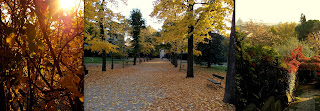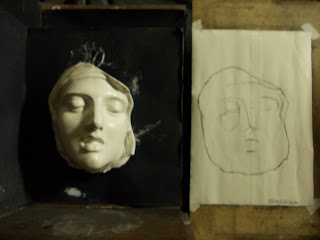It feels so good to have the midterm over with! And I think that for the first time in my life, I can say that I over-studied for an exam. I crammed a great many dates and patrons into my brain and was pretty much tested only on the works that I already knew before I started studying. Still, I’d rather study too much than not enough. Now I can identify works by Donatello, Brunelleschi, Michelozzo, Masaccio, Fra Angelico, Benozzo Gozzoli, Fra Filippo Lippi, Domenico Veneziano, Leon Battista Alberti and Luca Della Robbia. Phew!
And now that the exam is over, the project has been turned it…well, life has been pretty calm. And therefore, this post will probably be disjointed and all over the place. You have been warned. First, I want to prove to everyone that autumn has, finally, arrived in Florence. And it is beautiful.

I gave an oral presentation on the artist Andrea dal Castagno in my Medici art history class today. For this report, I was simply supposed to read Vasari’s account of the artist and give a summary. I was stoked for this assignment after I read Vasari’s chapter on Andrea because it had such a dramatic story in it. Andrea dal Castagno had a notable rivalry with painter Domenico Veneziano, with whom he was painting the chapel of Santa Maria Nuova in Florence. Because they were working together, Andrea pretended to be friends with Domenico despite his hatred for the talented foreigner. The story was, as follows: One summer evening, according to his custom, Domenico took his lute and went forth from S. Maria Nuova, leaving Andrea in his room drawing, for he had refused to accept the invitation to take his recreation with Domenico, under the pretext of having to do certain drawings of importance. Domenico therefore went to take his pleasure by himself, and Andrea set himself to wait for him in hiding behind a street corner; and when Domenico, on his way home, came up to him, he crushed his lute and his stomach at one and the same time with certain pieces of lead, and then, thinking that he had not yet finished him off, beat him grievously on the head with the same weapons. And finally, leaving him on the ground, he returned to his room in S. Maria Nuova where he put the door ajar and sat down to his drawing in the manner that he had been left by Domenico.
Meanwhile, an uproar had arisen. Everyone ran out of their houses including Andrea, who ran out to take Domenico in his arms crying, “Alas, my brother!” until Domenico finally expired in his arms. No one discovered who had killed Domenico and no one would have if Andrea had not confessed it on his death-bed. …a super intense story, right? And if anyone reading this post knows me, you know that I gave a dramatic reading of this account. However, my excitement at having the most exciting presentation in the class was quickly dashed to pieces. My professor praised my presentation and then, with a smile, told us how Vasari had actually made that entire story up. In fact, Andrea dal Castagno had died before Domenico Veneziano’s death so there is no way that Castagno could have brutally murdered him. And no, I don’t know why I was asked to do that presentation when it was all false…but hey, I got full marks so there you go.
I have been waiting to tell you all that the weekend before I left for London, I had a photoshoot! My Italian teacher, Stefano, is a budding photographer and in exchange for helping me fix my camera, he asked me to model for him. So we spent Sunday morning wandering around Florence while he took photos and told me odd historical and social tidbits about his city. It was a really fun morning and I finally got to see some of his photos. I am incredibly impressed with his photography (see more on his facebook page, Stefano Zanini) so I thought I’d share some of the photos with you.

Now, as annoying as cat-calls can be, I have to admit that I have gotten used to them. They are demeaning and misogynistic but in Italy, they are unavoidable. However, I also have quite a few piercings, including one on my face and a bar going through my upper ear, and half of my head is shaved so I get strange looks from everyone. I have gotten used to terrified looks from old women, blatant staring from young children and covert, intrigued glances from teenagers. Today was a bit different—I received two reactions to my appearance that I have given up trying to interpret. The first was when I walked out of my front door. An older man, probably in his eighties, was standing at the edge of the sidewalk holding a bag of trash. He turned his head to look at me behind him, let out a loud chuckle and threw his trash away. I giggled and moved along the sidewalk to wait for the bus. A little later, I was walking briskly across town fearing that I would be late for drawing class. Approaching me on the sidewalk was a man who looked vaguely Mayan—long black hair with grey streaks, a funny goatee and a colorful scarf. I saw him out of the corner of my eye and turned to look at him as I passed him on the sidewalk. He made direct eye contact with me, raised his eyebrows as high as they would go and shaped his mouth into a surprised “O”. And that was that.
I was not late to drawing and have now completed day three of my eight-day cast drawing of the Ecstasy of Saint Teresa. Here is a shot from day one.
And finally, tonight we had marzipan for dessert. Our host-parents’ son, Mattheo, had just brought it back from Sicily for them. It was the most delicious marzipan I have ever tasted…and it did not look at all like marzipan.
Oh! I almost forgot: yesterday THE HEAT FINALLY CAME ON!!! We were very excited.
I know your heads must be spinning by now so I will keep this last bit short. I’m not sure if you have heard of the terrible storms that have been happening across Italy now. A great deal of Rome was flooded and I just learned today that two towns of the Cinque Terre have been destroyed by landslides. One of these happens to be Monterosso, one of the first places that I visited in Italy. I’m not sure what the state of things are in terms of damage done or reparation plans but I thought I would pass that bit of information on and you can do research from there if you wish.
Alright, what a downer! So I shall leave you with an uplifting quote. Good night!
Let the world change you and you can change the world. –Che Guevara

















































